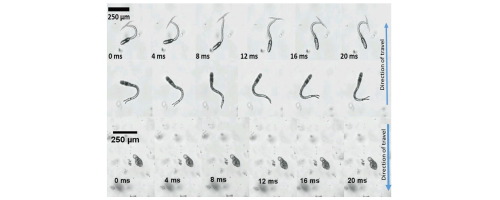当前位置:
X-MOL 学术
›
Int. J. Parasitol.
›
论文详情
Our official English website, www.x-mol.net, welcomes your
feedback! (Note: you will need to create a separate account there.)
Effects of temperature and viscosity on miracidial and cercarial movement of Schistosoma mansoni: ramifications for disease transmission.
International Journal for Parasitology ( IF 3.7 ) Pub Date : 2020-01-25 , DOI: 10.1016/j.ijpara.2019.12.003 K H Nguyen 1 , B J Gemmell 1 , J R Rohr 2
International Journal for Parasitology ( IF 3.7 ) Pub Date : 2020-01-25 , DOI: 10.1016/j.ijpara.2019.12.003 K H Nguyen 1 , B J Gemmell 1 , J R Rohr 2
Affiliation

|
Parasites with complex life cycles can be susceptible to temperature shifts associated with seasonal changes, especially as free-living larvae that depend on a fixed energy reserve to survive outside the host. The life cycle of Schistosoma, a trematode genus containing some species that cause human schistosomiasis, has free-living, aquatic miracidial and cercarial larval stages that swim using cilia or a forked tail, respectively. The small size of these swimmers (150-350 µm) dictates that their propulsion is dominated by viscous forces. Given that viscosity inhibits the swimming ability of small organisms and is inversely correlated with temperature, changes in temperature should affect the ability of free-living larval stages to swim and locate a host. By recording miracidial and cercarial movement of Schistosoma mansoni using a high-speed camera and manipulating temperature and viscosity independently, we assessed the role each factor plays in the swimming mechanics of the parasite. We found a positive effect of temperature and a negative effect of viscosity on miracidial and cercarial speed. Reynolds numbers, which describe the ratio of inertial to viscous forces exerted on an aquatic organism, were <1 across treatments. Q10 values were <2 when comparing viscosity treatments at 20 °C and 30 °C, further supporting the influence of viscosity on miracidial and cercarial speed. Given that both larval stages have limited energy reserves and infection takes considerable energy, successful transmission depends on both speed and lifespan. We coupled our speed data with mortality measurements across temperatures and discovered that the theoretical maximum distance travelled increased with temperature and decreased with viscosity for both larval stages. Thus, our results suggest that S. mansoni transmission is high during warm times of the year, partly due to improved swimming performance of the free-living larval stages, and that increases in temperature variation associated with climate change might further increase transmission.
中文翻译:

温度和粘度对曼氏血吸虫脑和小脑运动的影响:疾病传播的后果。
生命周期复杂的寄生虫容易受到与季节变化相关的温度变化的影响,特别是作为依赖于固定能量储备在宿主外部生存的自由活动幼虫。血吸虫是一种吸虫,其生命周期包含一些会导致人类血吸虫病的物种,其生活阶段分别是纤毛或叉尾游动的自由生,水生生和子car幼虫期。这些游泳者的体型较小(150-350 µm),表明他们的推进力主要由粘性力决定。考虑到粘度会抑制小型生物体的游动能力,并且与温度成反比,因此温度的变化应会影响自由活动幼体阶段游动并定位宿主的能力。通过使用高速摄像机记录曼氏血吸虫的和尾car运动,并独立地操纵温度和粘度,我们评估了每个因素在寄生虫游泳机理中的作用。我们发现温度对水acid和骨速度的正影响和粘度的负影响。雷诺数描述了施加在水生生物上的惯性力与粘性力之比,在所有处理中均小于1。当比较在20°C和30°C下的粘度处理时,Q10值<2,进一步支持了粘度对水acid酸和尾car速度的影响。鉴于两个幼虫阶段的能量储备都很有限,并且感染需要消耗大量能量,因此成功传播取决于速度和寿命。我们将速度数据与整个温度下的死亡率测量值结合起来,发现在两个幼虫阶段,理论上的最大距离都随着温度的升高而降低,并且随着粘度的降低而降低。因此,我们的结果表明曼氏沙门氏菌在一年的温暖时期传播较高,部分原因是自由活动幼虫阶段的游泳性能提高,并且与气候变化相关的温度变化的增加可能会进一步增加传播。
更新日期:2020-01-26
中文翻译:

温度和粘度对曼氏血吸虫脑和小脑运动的影响:疾病传播的后果。
生命周期复杂的寄生虫容易受到与季节变化相关的温度变化的影响,特别是作为依赖于固定能量储备在宿主外部生存的自由活动幼虫。血吸虫是一种吸虫,其生命周期包含一些会导致人类血吸虫病的物种,其生活阶段分别是纤毛或叉尾游动的自由生,水生生和子car幼虫期。这些游泳者的体型较小(150-350 µm),表明他们的推进力主要由粘性力决定。考虑到粘度会抑制小型生物体的游动能力,并且与温度成反比,因此温度的变化应会影响自由活动幼体阶段游动并定位宿主的能力。通过使用高速摄像机记录曼氏血吸虫的和尾car运动,并独立地操纵温度和粘度,我们评估了每个因素在寄生虫游泳机理中的作用。我们发现温度对水acid和骨速度的正影响和粘度的负影响。雷诺数描述了施加在水生生物上的惯性力与粘性力之比,在所有处理中均小于1。当比较在20°C和30°C下的粘度处理时,Q10值<2,进一步支持了粘度对水acid酸和尾car速度的影响。鉴于两个幼虫阶段的能量储备都很有限,并且感染需要消耗大量能量,因此成功传播取决于速度和寿命。我们将速度数据与整个温度下的死亡率测量值结合起来,发现在两个幼虫阶段,理论上的最大距离都随着温度的升高而降低,并且随着粘度的降低而降低。因此,我们的结果表明曼氏沙门氏菌在一年的温暖时期传播较高,部分原因是自由活动幼虫阶段的游泳性能提高,并且与气候变化相关的温度变化的增加可能会进一步增加传播。











































 京公网安备 11010802027423号
京公网安备 11010802027423号